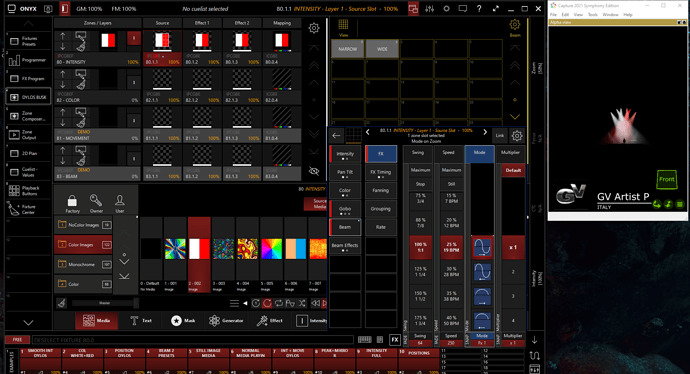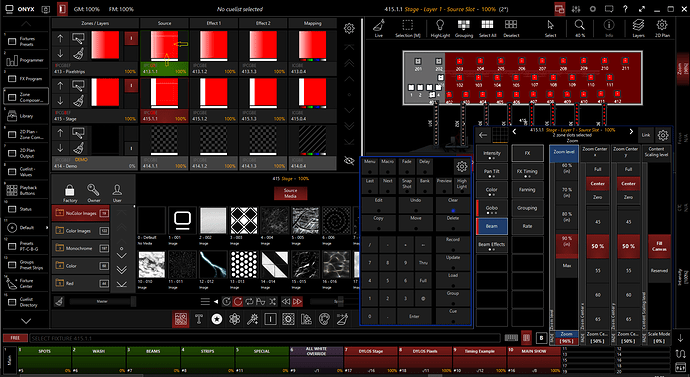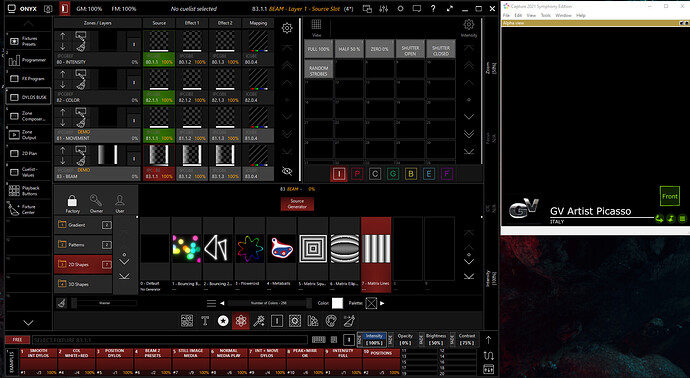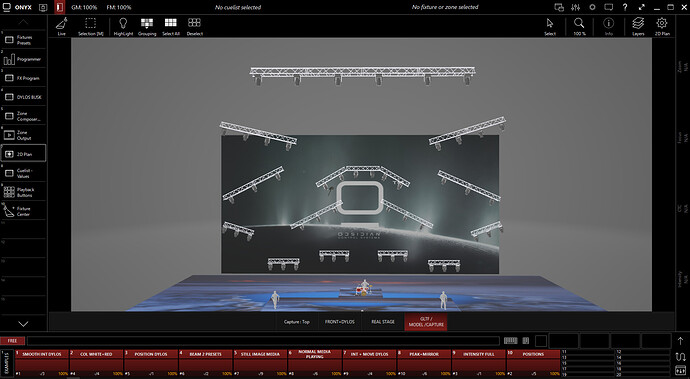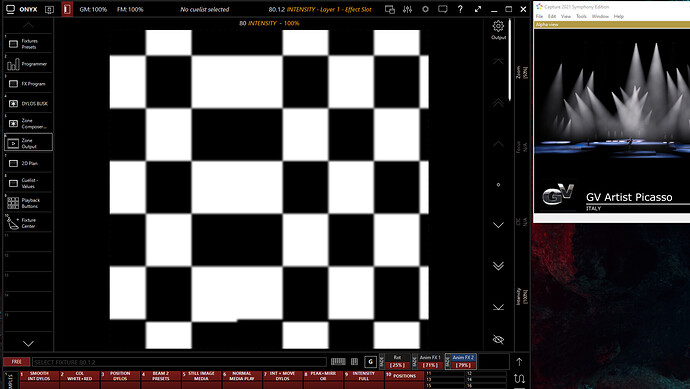The ONYX 4.6 development cycle is now completed. Some minor housekeeping remains, but this version contains all planned features.
Thanks for all the bug reports and notes to finalize the release! Our team very much appreciates all comments and suggestions, even though not all can be considered for this release.
This version changes the licensing system.
Be careful when testing this as the “free” Universes are changed. So if you do not own a ONYX Wing or Key be mindful of the Universes you need.
EtherDMX Universes are now REDUCED to 1 free Universes unless Obsidian Hardware is detected.
Netron devices will require a firmware upgrade to enable ONYX unlocking, it will be available with the 4.6 release.
For a summary of the licensing changes please see:
New ONYX 4.6 Licensing for PC Systems (obsidiancontrol.com)
Download the Release Candidate 1216 for consoles and PC:
Ensure to keep the latest library installed, which is replaced daily. The RC1216 contains the 07/13/2021 library.
Download the package and report all issues back using the 4.6 form.
Fixture Library (4.6 Preview) (obsidiancontrol.com)
Current content package:
The complete list of changes since 4.4:
Release Notes for Onyx
(C) 2018-2021 - Obsidian Control Systems
4.6.12xx (–/07/2021)
This version requires Windows 10 Home/Pro/Enterprise 64bit for PC. All consoles require a new 4.6 ONYX OS.
Compatible with ONYX NX4, NX2, NX Touch, NX-DMX
Compatible with M-Series M1 HD, M2GO HD, M6 (with ONYX Upgrade), M-Touch, M-Play, USB-DMX devices
Please note: Many parameter defaults and behaviours of fixtures are changed. Verify existing shows carefully as they may require programming adjustments.
Licensing
Please note! This version removes FREE Universes 2,3 and 4. Only Universe 1 is unlocked in ONYX FREE Mode.
Onyx FREE
Without an ONYX USB or NETRON device attached, the software runs in FREE mode.
Universe 1 is completely free to use for Art-Net and sACN protocol output.
2 DyLOS Zones are enabled. Additional zones show a random watermark.
OSC Playback, MIDI, and all timecode protocols can be enabled for a short time period for testing and evaluation. Once the allowed time is expired, ONYX must be restarted to allow a new test period.
Onyx NOVA
With an ONYX USB or NETRON device attached, the software runs in NOVA mode.
Universe 1-4 is completely free to use for ONYX USB, Art-Net, and sACN protocol output.
2 DyLOS Zones are enabled. Additional zones show a random watermark.
OSC Playback, MIDI, and all timecode protocols can be enabled for a short time period for testing and evaluation. Once the allowed time is expired, ONYX must be restarted to allow a new test period.
Connected Touch or Play devices will also remove all I/O protocol restrictions (NOVA+)
Onyx Essential
With an ONYX Essential Key attached, the software runs in LIVE 8 mode.
Any 8 universes are completely free to use for ONYX USB, Art-Net, and sACN protocol output.
2 DyLOS Zones are enabled. Additional zones show a random watermark.
OSC Playback, MIDI, and all timecode protocols are fully enabled.
Onyx Premier
With a Premier Key, NX Wing, or NX 2 in USB mode attached, the software runs in LIVE 64 mode.
All 64 universes are completely free to use for ONYX USB, Art-Net, and sACN protocol output.
5 DyLOS Zones are enabled.
OSC Playback, MIDI, and all timecode protocols are fully enabled.
Onyx Elite
With a Key attached, the software runs in LIVE 128 mode.
All 128 universes are completely free to use for ONYX USB, Art-Net, and sACN protocol output.
5 DyLOS Zones are enabled.
OSC Playback, MIDI, and all timecode protocols are fully enabled.
New fixture library format
This version introduces a new fixture libary format, provided by the new libary partner AtlaBase. This library includes over 50.000 fixture profiles
Please review all required fixtures carefully and request missing fixtures and report errors, wrong defaults etc on the new fixture request page.
Existing fixtures will remain in the showfile but can be replaced using the “Exchange” function in the patch menu.
User fixtures and the Library Editor are not affected and remain available.
New Fixture Libraries are only availble for Version 4.6 and higher.
- Daily update of new library package on Obsidiancontrol.com
- Single file library package (no longer an installation)
- Faster software install, bootup, library udpates
- Update libary from System Menu /Tools/Maintenance
- Library data is perfectly syncronized with Capture fixtures, allowing for easy import of the patch over CITP
- Revised Parameter Defaults and Snap Rules(e.g.additive LED fixtures now have all colors defaulted to 100%)
- → this can affect existing programming and cues and presets must be adjusted if needed.
- Enhanced real world values (e.g. Zoom Ranges, Shutter Speeds, Framing Blade Angles)
- Improved Parameter names and feature descriptions
- Enhanced gobo and effects bitmaps, color buttons for CTC and Color Wheel Selections
New Features
New virtual controls icon, expands bank and parameter control into full Playback and Programming Bar
Added “DMX OUT” option in LOAD popup window to “freeze” effects output into the programmer
Effect/timing channels can now also be used as “[SELECTION] @ Parameter Button” for direct entry and fanning on the command line (digital values only: swing ranges 0-170, other attributes 0-1000)
Time for automatically loading the current show on startup can now be configured
Added fixture type filter to programmer and cue values panels; fixes and improvements
Added Art-Net/sACN source IP input filtering
Added Capture (CITP) integration (patch, selection, parameter sync)
Added import of patch (exported from another Onyx show file)
CITP integration pulls in 3D positions to compose a top and front 2D plan of the stage (layer per fixture type)
Added MSD (CITP) integration
Added DEFAULT command to put default values in programmer
Added current universe fixture filter in patch
Added patch options for excluding fixtures from GM, SWOP, remote programming and for rotating bars and panels at DMX address level
Added option to turn off smart grid ordering of fixtures in FixtureCenter
DYLOS
DyLOS can now apply pixel mapping for any fixture parameter between 2 and 3 presets
Added DyLOS generators:
- Patterns: Plasma, Voronoi
- 2D Shapes: Bouncing Balls, Bouncing Shapes, Meta-balls, Floweroid
- Nature: Fire, Steam
Added color palettes to Dylos (First row of 256 pixels in PNG image are used to map - generator output - intensity levels to indexed colors)
Added 2 and 3-preset pixel mapping mode and opacity mapping modes
Dynamic Intensity mapping is now the default
Added white mapping mode to DyLOS to include all emitter channels (e.g. white, amber, lime) in pixel-mapping to better represent unsaturated colors on stage: it also uses color information and relative brightness data of all color emitters to balance emitter brightness, as well as apply color temperature across emitter channels for unsaturated colors
Added feedback to indicate alpha information availability in content
Missing content is now also indicated on the content type (media, text, …) tabs
Added “intensity + other emitters” mapping mode for fixtures without RGB emitters but with various other emitter types
Added “background color” effect and “masks as background” mode to masks
Added color palette generator/editor
Added configurable DyLOS thumb overlays, optionally showing curves for matrix generators and mapping gamma curves
DyLOS Framing and Iris will now follow opacity mapping (indicated using hatching pattern)
Added DyLOS zone output panel
Anti-aliasing in DyLOS can be disabled for better pixel accuracy
DyLOS framing now is corner point oriented instead of “blade” oriented
Added DyLOS mirror effect
Added DyLOS tunnel effect
Added framing and iris to DyLOS zone slot
Added DyLOS frame blending
Added DyLOS thumbnail feedback options
Continous/loop improvements on DyLOS
Fixed fixture rotation on 2D plan being ignored for pixel mapping
Fixed pixel mapping to ignore master parameters specifically
Added new parameters for new DyLOS effects and generators
Improved CMY mapping to favor intensity channel to color saturation channels (to limit color flag usage and to avoid non-pure blacks)
DyLOS manual values and origin are now shown in live output
DyLOS zones slots can now be expanded/collapsed in Fixture Center
DyLOS values are now shown in live output
Added options menu to zone composer
Weight modes allow for selecting “Zone Intensity” (default, backward compatible, LTP) and the newer “Manual Weight” (which has improved)
Fixed value changes in DyLOS zone composer not being synchronized over the network
Replaced LTP with programmable weight control between direct and pixel mapped programming
Improvements
Live output arranges some small footprint fixtures (intensity only, color mixing only, …) in multiple columns
Updated internal web browser with Edge/Chromium-based for improved help browsing, license management, Art-Net node management and RDM browsing experience
2D plan now visualizes all color emitters
Added edit cue button and the direct cue view to playback context popups
Keypad show/hide toggle can now also be assigned to an F-Key
Improved programmer, cue values and live output panels:
- Improved integration with scroll and toolbar workflows
- Added fixture names & colors, and fixture type colors
- Fixed issues with fixture(-type)s that have large channel footprints
- Improved performance
Programmer and cuelist values panels can now be placed more than once
Improved Art-Net and sACN input options
Improved orientation of fixtures on Capture import
Installer improvements to avoid SQL-related errors in uninstall of 4.5.1205 builds and later
Improved responsiveness of OSC playback page actions and fixed OSC refreshes
Improved 2D plan performance and responsiveness
Added LTC audio input level control for Obsidian timecode boards
Increased maximal cue comment size
Improved Onyx startup sequence, should eliminate startup errors
Updated NX Remote app
Enabled Art-Net on any (sub)net and updated network configuration accordingly
Added sACN priority configuration
Added support for stVisual style so Visualizers always - also when utilizing Unicast - receive licensed Art-Net data
Full software and hardware support for flipping playback faders 1-10 with 11-20
Improved P/T Combo handling
Fixes
2D plan icon corruption when swapping fixtures
GO on playback resetting to cue 1 on secondary (in tracking backup) after it turned standalone
Art-Net IN loopback issues
UI closing after selecting cuelist type when recording to a new cuelist
Custom colors on fixtures, types, cuelists, etc
UPDATE+UPDATE to referenced preset(s) not updating cue values
Cleaning faulty fixture types from show files, preventing adding fixtures when type was fixed
DyLOS generator animation
DyLOS opacity mapping
first fixture in patch not having its opacity mapped correctly
fixture selection focus for multi-part fixtures without a main part
LOAD+LOAD using keyboard shortcut
copying between types of Fixture Groups
playback fader (1-10) LEDs on M-Touch, NX Touch while not in “Play” mode
error popup in selected cuelist view when using keyboard shortcut to delete cues
applying additive color FX macros
optimizing show files (removing fixtures that had been marked for deletion)
placing multi-part fixtures on 2D plan
playback status redraw issue when returning from patch
M-Play bank issues
“push to all” not refreshing on virtual playback panel
back button freezing on “Follow 0s” cues
joining shows
popups appearing multiple times at startup
multiple conditional channels not toggling (for example, Frost disabling 2 prisms on ADJ Focus Beam LED)
deselecting fixture in Capture not deselecting in Onyx
focusing inconsistencies with Capture for P/T inverted/swapped fixtures
IP address and numeric up/down entry issues

